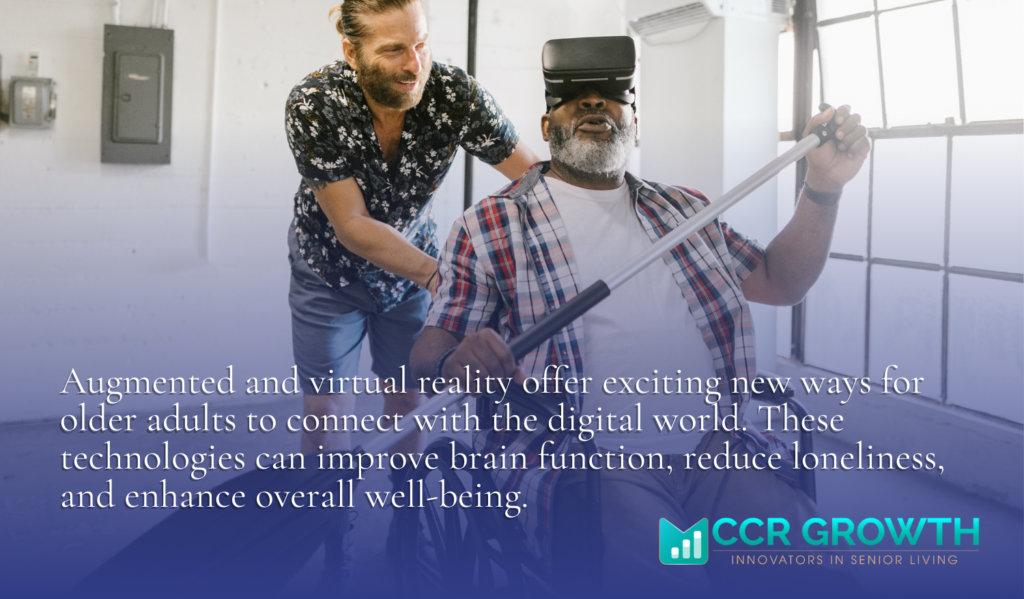
CCR Growth
How Tech Empowers Older Adults
The aging landscape is changing. As our life expectancy increases, so does the need for innovative solutions to address the challenges faced by older adults. Thankfully, technology is stepping up to the plate, offering a wide range of possibilities to empower older adults, improve their quality of life, and foster greater independence.
According to an AARP survey, older adults in the U.S. are increasingly embracing technology, spending a significant $77 billion on tech in 2022 alone. This trend is expected to continue, with spending projected to reach $120 billion by 2030. However, many older adults feel that current tech products don’t fully meet their needs.

Outline
Published on
25/09/2024
To capitalize on this growing market, it’s essential to design technology with the end-user in mind. Remember, the older adult population is diverse, with individuals spanning five decades and facing varying challenges. Catering to their specific needs and preferences is crucial for success.
Gerontechnology: Bridging the Gap
Gerontechnology, a dedicated field focusing on technology designed for older adults, should aim to prioritize independent living and social participation, according to the International Society of Gerontechnology (ISG). This encompasses a wide range of assistive technologies, ranging from the simple to the sophisticated, all with the goal of keeping older adults safe, connected, and engaged. We know that the challenges faced by older adults are multifaceted:
- Cognitive and Mental Health: While some age-related cognitive decline is normal, it can impact daily functioning.
- Physical Health: Chronic conditions, mobility limitations, and sensory declines (hearing and vision) are more prevalent with age.
- Social Isolation: Loneliness can significantly affect well-being, especially for those living alone.
These challenges can rob older adults of their independence and quality of life. Here’s where gerontechnology shines. According to the ISG, technology should serve older adults by maintaining their independence and equality, supporting their health and well-being according to WHO standards, answering individual and social ambitions, ensuring they remain active in their socio-cultural environment, enhancing their dignity, and supporting their caregivers.
Tech for a Brighter Tomorrow

There is an ever-growing list of tech solutions available aimed to help us navigate the challenges posed by old age. We’ve highlighted a few that have caught our attention:
Combating Loneliness and Fostering Connection:
Eve Companion: This voice-activated virtual companion bridges the gap by providing social interaction, encouraging games, learning activities, and even facilitating connections with real people. According to founder Ivan Wicksteed, loneliness and social isolation disproportionately affect older generations – particularly those who live alone, which is the inspiration behind his development of Eve Companion. “Eve is a virtual companion accessible by phone – the old fashioned kind – from the comfort of your own home. She requires no skills to use – you just plug her in and start talking. Eve develops an individual relationship with each user, encouraging you not just to chat but also to play games, learn new recipes, meet other (real) people – she even hosts a daily yoga class,” he explains in a LinkedIn post.
Notably, this tech has achieved accessibility, both from a cost standpoint and from a user-friendly point of view. With its familiar design (a retro telephone) and plug-and-play functionality, Eve Companion offers a great example of putting tech within reach of older generations.
Enhancing Healthcare and Wellness:
Augmented and virtual reality offer innovative solutions to bridge the gap between older adults and the digital world. These technologies can provide immersive experiences, aimed at improving cognitive function, reducing social isolation, and enhancing overall well-being. For example, virtual reality can simulate travel experiences, allowing older adults to explore new places without physical limitations. It can also be used to assist older adults in rehabilitation. For example, IF Smart Health designs virtual reality software that provides immersive and engaging therapeutic experiences. Meanwhile, augmented reality can overlay digital information onto the real world, aiding in navigation, and task completion. By harnessing the power of AR and VR, we can create more inclusive and engaging environments for older adults.
Promoting Safety and Security:
Smart lighting, voice-activated routines, and wearable devices help minimize fall risks and improve accessibility so that older adults can stay independent and connected to family and caregivers. According to Andrew Valyear, owner at Uplynk, creating solutions like these is key to ensuring older adults continue to live independently, safely. Integrating smart home security systems offering real-time monitoring and emergency response is another way to ensure technology is geared toward working for older adults.
Maintaining Independence and Autonomy:
The formation of Age Tech Collab by AARP to offer an industry-driven accelerator program, underscores the substantial interest in tech solutions empowering older adults. It highlights the growing market for technology aimed at the aging population.
The Power of Technology
Technology offers so many benefits to older adults:
- Increased Independence: Tech solutions can help seniors manage daily tasks, navigate their homes more safely, and remain in control of their lives.
- Improved Communication: Virtual companions, video calls, and social media platforms facilitate connection with loved ones and combat feelings of isolation.
- Enhanced Safety: Wearables and smart home systems provide peace of mind for both seniors and their caregivers by monitoring health data and offering emergency response options.

Navigating the Challenges
While technology offers incredible potential, challenges remain.
- Digital Divide: Not all older adults have access to technology or feel comfortable using it. User-friendly designs and favorable price points are a vital aspect of developing successful products.
- Privacy Concerns: Data security and privacy protection are crucial considerations when adopting new technologies.
Overcoming Obstacles and Embracing Possibilities
While there is major potential for market growth, organizations and companies designing tech to provide solutions should strive to bridge the digital divide. Senior living communities can play a vital role by offering training sessions and ensuring user-friendly interfaces. Where possible, integrating technology within senior living communities to enhance their operations and resident experiences can be another vital way communities can embrace gerontechnology. Additionally, encouraging open communication and education about privacy concerns and offering transparent security measures fosters trust. Finally, exploring cost-effective solutions and seeking financial assistance programs can help make technology accessible to a broader range of older adults.
Wrap-Up
Technology is no longer a luxury for older adults; it’s a potential pathway to an empowered, connected, and independent future. Senior living professionals, caregivers, and older adults themselves are encouraged to explore these solutions and consider how they can be integrated into individual lives or community settings. By embracing technology, we can redefine aging and empower older adults to live their best lives.
Want to stay ahead of the curve in senior living technology? Let’s discuss how we can help you implement cutting-edge solutions. Get in touch.
Subscribe to our newsletter
Sharpen your expertise and stay ahead of senior living industry trends—subscribe to CCR Growth’s newsletter for exclusive insights and updates.
Recent Posts



A Complete Guide to Generative Engine Optimization for Senior Living
Redefining Senior Living Marketing, Sales, and Operations
CONTACT ADDRESS
8710 Carmel Valley Road, Carmel, CA 93923
GENERAL INQUIRIES
info@ccrgrowth.com
(831) 273-3628
SOCIAL MEDIA




